Carpet manufacturing got its start in the United States in 1791 when William Sprague opened a carpet mill in Philadelphia. The Northeast remained the center for carpet manufacturing until the 1930s, when manufacturing of tufted carpets took off in Dalton, Georgia. In 1928, Marshall Field introduced a machine-made rug that looked like an Oriental carpet and created the Karastan Company.
But today’s most exquisite carpets still trace their history to, and usually are manufactured in, the Middle East, where carpets began to be hand woven as early as the 2nd and 3rd Centuries BC. “They weave the choicest and the most beautiful carpet in the world,” Marco Polo said of the carpets he encountered during a trip through Turkey in the late 1200s. “They also weave silk fabrics of crimson and other colors, of great beauty and richness, and many other kinds of cloth.”
It took revolutions to move the best of the carpet business nearly 8,000 miles across the world to West Hollywood. Mansour Fine Rugs’ Benjamin Soleimani, Aga John’s Jerry Illoulian, Mehraban Rugs’ Sam and Soheil Mehraban, Modern Rugs L.A.’s Sasha Masjedi, Jimmy’s Rugs’ Mohaber Jimmy, Ariana Carpets’ Ahmadi family. They are a few of those who fled or are the descendants of people who fled countries such as Iran during the late 1970s and early 1980s after the fall of the Shah and Afghanistan during the Soviet invasion to prop up the communist government.

Ahmad and Alex Ahmadi, their sister Nadia and their mother Kobra are part of a family that has been in the rug business for over 80 years. The Ahmadis were the first in Afghanistan to make rugs solely from silk and their perfectionism, creativity and talent gained them recognition with European buyers in the ’60s and ’70s. Their lives changed forever in 1979 when the Russian Army invaded and the Ahmadis were smuggled out of Afghanistan one by one. They left behind everything except their passion for rug making.
After living in Germany for six years, the Ahmadis moved to Northern California with high hopes, but unfortunately work wasn’t as easy to come by as they had expected. So they headed south. “West Hollywood was known for its design industry. It had, and still has, so much to offer a person in search of beautiful things,” said Ahmad Ahmadi. In 1986, the Ahmadis settled into a small apartment in the heart of West Hollywood. Ahmad would repair rugs out of his living room, working from 8 a.m. until 2 a.m. while listening to American television so he could learn English. On weekends he and his brother Alex would make the long drive to San Francisco to buy used rugs they would repair and sell in Los Angeles.
Four years later, Ahmad was finally able to order a container of flat weaves from Afghanistan, and Ariana Rugs was born. Although West Hollywood is home, the Ahmadis have never forgotten their roots. In 2001, with Afghanistan free from the Taliban, the Ahmadi family re-established a factory there.

“We started with nothing,” Ahmad Ahmadi said. “No infrastructure, no electricity, no running water. But we were dedicated and determined to make it happen. We had employees over there that we felt obligated to.” With a few looms and some employees that were more than happy to return to work for the Ahmadis, the rug making began. The rug makers wove and loomed as they had done 24 years earlier, creating magnificent pieces of art, some taking up to three years to finish.
The Ahmadis have advocated for change. Ariana Rugs is the first company with workers in Afghanistan to be recognized by Goodweave, an organization focused on ending child labor in the hand-woven carpet industry. “Afghanistan is synonymous with rugs, and its beautiful craft and artwork that has been handed to us,” Ahmad Ahmadi said. “We are responsible for taking it to the next generation. We want the world to see that these rugs are made by professionals, not by kids, and there is no child labor used to make our products.”
In 2003 Ariana Rugs made its debut at the Atlanta International Rug Show with 32 rugs made in Afghanistan. The show was not a success for Ariana, but the Ahmadis had hope. In 2005, their determination and dedication paid off, and Ariana Rugs sold the most expensive rug in the Atlanta Rug Show’s history. In 2009 Ariana Rugs won the Magnificent Carpet Award, the rug and home industry’s signature event, in Atlanta, and the winning piece was displayed in the Museum of Asian Art in Moscow for one month. That same rug is now hanging in the West Hollywood Library.
According to Ahmad Ahmadi, the key to the success of Ariana Rugs is more than attention to detail. It’s attention to all of the details—the materials, the rug- making process, the presentation and what their customers want. While Ariana Rugs makes rugs that look as if they are 300 years old, Ahmadi says they use colors and patterns to make them fit today’s fashion. “The younger generation”, he said, “wants quality but has its own idea of style and design.”
Ariana Rugs is nestled in the heart of West Hollywood on Robertson Boulevard. Ahmad Ahmadi said he finds inspiration in his surroundings. “I spend most of my time in a one-mile radius, and I’m still not sick of it, from the beautiful restaurants to the beautiful showrooms to the amazing people. The people are so friendly. It’s a place where you are free to be yourself and not be judged. I am inspired by this city every day.”
The family is as close knit as the rugs it creates. The business is run by Ahmad and Alex with their mother, Kobra, and sister, Nadia. “I adore my business partners, best business partners in the world. I couldn’t do it without them,” Ahmad Ahmadi said. From repairing rugs on a living room floor to selling rugs nationally and internationally, they have come a long way.
“You have to enjoy what you do,” Ahmad said, smiling as he looked up at the slowly rotating ceiling fan at Tortilla Republic restaurant down the street from Ariana. “You have to create self-fulfillment. That’s what ‘making it’ really means.”
This story was originally published in the March / April issue of West Hollywood Magazine. A copy of the magazine can be accessed online. It currently is being delivered door-to-door in some neighborhoods and is available at shops such as Camerich and Gloster on Robertson Boulevard and Custom Comfort Mattress on Beverly Boulevard.

A lovely article and welcome to Alex and Ahmad Ahmadi of Ariana. Looking forward to seeing their fine rugs.